
Cordoba’s Mosque and
Granada’s Alhambra are the unrivalled icons of the
Moorish architecture in Western Europe. Today the mosque
is still a functioning worship space as it has been since
at least the 5th century. In that time, it’s been
the world’s second largest mosque and one of many
pretty good cathedrals in Spain. Here you walk from the
Islamic world to the Christian – and back without
going outside.
By itself, the town of Córdoba is well worth the
visit as a historical and well-preserved Andalusian town.
But with this remarkable building, stopping here is
de rigueur. With the
possible exception of Granada’s Alhambra, this is
the most significant Moorish building in Western
Europe.
If you think that's a Christian cathedral poking through
the roof, you're right. Without those modifications (some
would say abominations), this might look like the roof of
a factory. You could also make the case that if this
building hadn't been converted to a cathedral after the
Christian
reconquista, the entire structure would have been
torn down.
The Umayyad
Migration
When built, this was Islam's 2nd largest mosque.
But why in Córdoba?
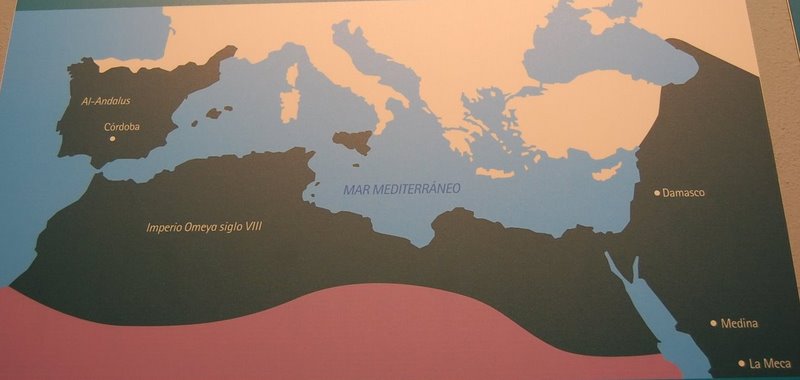
Here's why. The map above shows the realm of the Arab
Umayyad Dynasty which evolved from a tribe of merchants
who became successful administrators under Muḥammad
in Mecca. When civil war broke out after the prophet's
death, their descendants became caliphs. Moving the
capital north to Damascus, they built the Syrian army
into their power base -- but eventually they were
overthrown after unsuccessful foreign wars and a
financial crisis. (Aren't you glad that can't happen to
us!) By 750, the Umayyads were prey to the new Abbasid
regime -- whose goal was to kill every remaining member
of the clan.

But ʿAbd al-Raḥmān I escaped to Al-Andalus, where in 755 he convinced
the warring Arab factions there to make him their emir (a rough
equivalent to a prince).
Convincing the Iberian Arabs to cede hegemony to a fleeing Umayyad may
not have been difficult. While it took the Moors only about 3
years to subdue most of Visigoth Iberia, they had much more difficulty
subduing themselves. Factional disputes gave the first 22 Andalusian
emirs reigns lasting an average of 2 years.
Nicknamed “the Falcon,” ʿAbd al-Raḥmān I turned out to be a
remarkable ruler in the 32 years until his death. He strengthened
trade, introduced grapefruit, figs, and other crops into Spain, and
wandered about Córdoba (which would grow to about 100,000
population in his day) without bodyguards.
Many of the former Umayyad administrators then fled Damascus and
settled in what was to soon become one of the most important cities in
Europe – Cordoba. Eventually the Umayyads proclaimed their rule
to be a Caliphate, which meant they viewed themselves as successors to
prophet Muhammad's authority. Such pretensions required a mosque
suitable to buttress these claims. By 785 ʿAbd al-Raḥmān I had built
one which would be expanded by his successors 3 times. Some enhanced
with style and some with only volume. By the turn of that millennium,
Cordoba's Mezquita was the largest in the world save for the pilgrimage
mosque in Mecca.
Architecture as destiny
Eventually the Umayyads proclaimed their rule to be a
Caliphate, which meant they viewed themselves as
successors to prophet Muhammad's authority. Such
pretensions required a mosque suitable to buttress these
claims.
By 785 ʿAbd al-Raḥmān I had built one
which would be expanded by his successors 3 times. Some
enhanced with style and some with only volume. By the
turn of that millennium, Cordoba's Mezquita was the
largest in the world save for the pilgrimage mosque in
Mecca.
Salvation through conversion
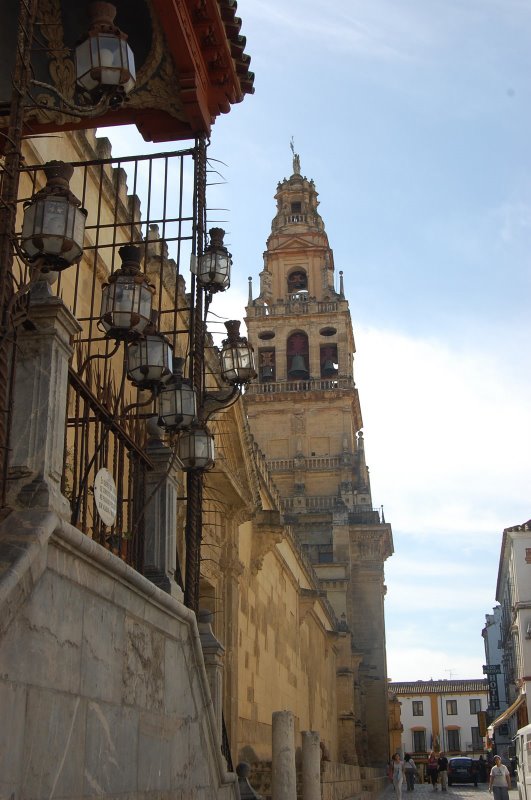
Most Spanish mosques are boxy, flat–roofed
buildings with a minaret tower climbing high into the sky
to help summon the faithful to prayer. Often Christians
added the accoutrements of a bell tower atop the minaret
when they repurposed the structure as we see in the above
picture. (The few mosques that survived in Spain were
usually converted to Christian churches.)
Exterior Walls
Mosque exterior walls are typically plain, save for a
fancy doorway or two. Cordoba’s mosque walls are
huge, but occasionally their austerity is interrupted by
decorations from the Moors and the Christians as well.
For instance, (below) we see one of the many shrines that
the Christians added to the Mezquita’s walls. the
popular shrine to “Our Lady of the Lanterns”
with a copy of a painting by Julio Romero de Torres. The
son of the director of the town's art museum, Torres was
born in Cordoba and has a museum to his work here on the
same square as Cordoba’s art museum which was
directed by his father. He died here in 1930 but traveled
far in distance and artistic style in between.
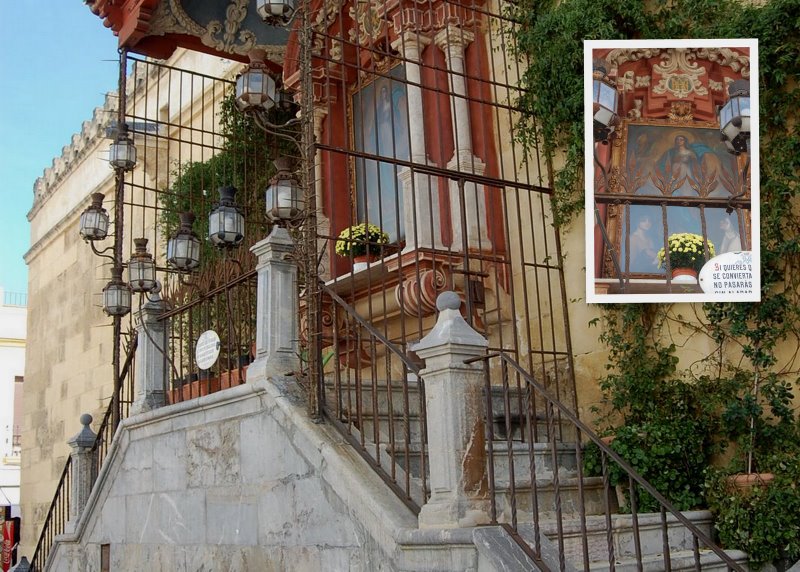
The west wall of the Mezquita (at right in the picture
below) shows one of the Mosque's more decorated sides. At
left was the bishop’s palace, now converted to
a convention center.)
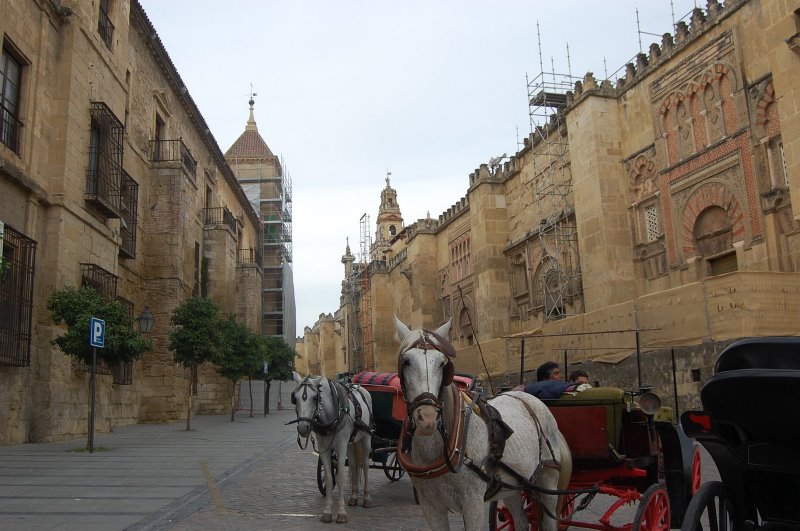
The decoration here is primarily the Moorish arches
including those with 3 and 5 lobes. Multi-lobe arches are
also a decorative motif in the interior.
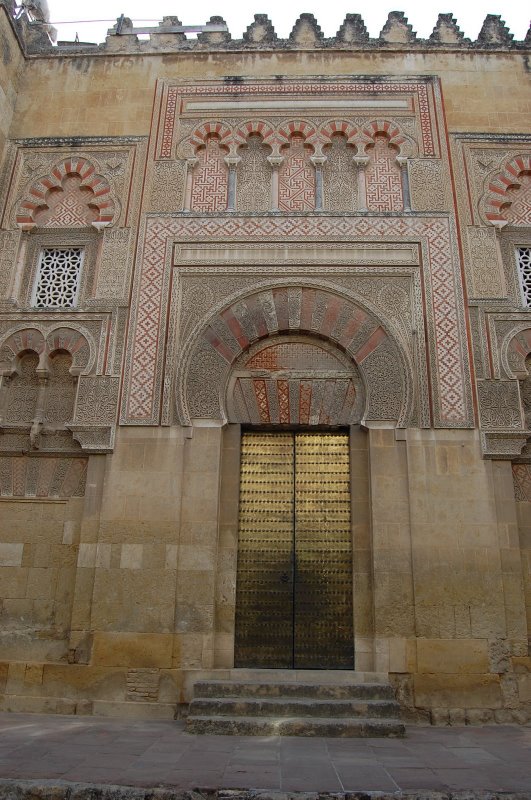
The exterior walls originally had many shops whose
rent paid for the upkeep of the mosque and cathedral.
These were removed for aesthetic purposes and the
town’s meat markets were tasked with paying for the
cathedral’s upkeep. Tithes were also required, but
the king took some of the revenue for his own use,
starving the maintenance program.
After the Christian conquest of Cordoba, the mosque
was in danger of collapse from poor maintenance.
Christians taxed Muslim artisans to donate their skilled
labor to repairs. The Muslim population got so squeezed
by taxes (far in excess of their surrender agreement)
that they revolted in 1264 -- causing the Castilian king
to treat them even worse.
Let's now enter the complex through the Gate of
Pardons attached to the old minaret. Please join us
by clicking here.
Please join us in the following slide show to
give Córdoba the viewing it deserves by clicking here.
|
|
|
|
